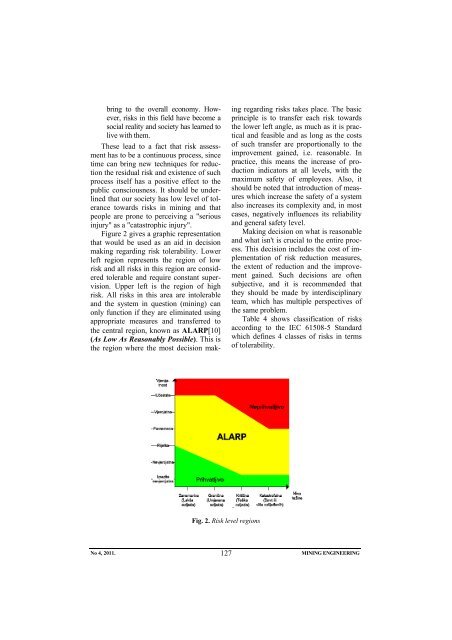Rudarski radovi br 4 2011 - Institut za rudarstvo i metalurgiju Bor
Rudarski radovi br 4 2011 - Institut za rudarstvo i metalurgiju Bor
Rudarski radovi br 4 2011 - Institut za rudarstvo i metalurgiju Bor
Create successful ePaper yourself
Turn your PDF publications into a flip-book with our unique Google optimized e-Paper software.
ing to the overall economy. However,<<strong>br</strong> />
risks in this field have become a<<strong>br</strong> />
social reality and society has learned to<<strong>br</strong> />
live with them.<<strong>br</strong> />
These lead to a fact that risk assessment<<strong>br</strong> />
has to be a continuous process, since<<strong>br</strong> />
time can <strong>br</strong>ing new techniques for reduction<<strong>br</strong> />
the residual risk and existence of such<<strong>br</strong> />
process itself has a positive effect to the<<strong>br</strong> />
public consciousness. It should be underlined<<strong>br</strong> />
that our society has low level of tolerance<<strong>br</strong> />
towards risks in mining and that<<strong>br</strong> />
people are prone to perceiving a "serious<<strong>br</strong> />
injury" as a "catastrophic injury".<<strong>br</strong> />
Figure 2 gives a graphic representation<<strong>br</strong> />
that would be used as an aid in decision<<strong>br</strong> />
making regarding risk tolerability. Lower<<strong>br</strong> />
left region represents the region of low<<strong>br</strong> />
risk and all risks in this region are considered<<strong>br</strong> />
tolerable and require constant supervision.<<strong>br</strong> />
Upper left is the region of high<<strong>br</strong> />
risk. All risks in this area are intolerable<<strong>br</strong> />
and the system in question (mining) can<<strong>br</strong> />
only function if they are eliminated using<<strong>br</strong> />
appropriate measures and transferred to<<strong>br</strong> />
the central region, known as ALARP[10]<<strong>br</strong> />
(As Low As Reasonably Possible). This is<<strong>br</strong> />
the region where the most decision mak-<<strong>br</strong> />
Fig. 2. Risk level regions<<strong>br</strong> />
ing regarding risks takes place. The basic<<strong>br</strong> />
principle is to transfer each risk towards<<strong>br</strong> />
the lower left angle, as much as it is practical<<strong>br</strong> />
and feasible and as long as the costs<<strong>br</strong> />
of such transfer are proportionally to the<<strong>br</strong> />
improvement gained, i.e. reasonable. In<<strong>br</strong> />
practice, this means the increase of production<<strong>br</strong> />
indicators at all levels, with the<<strong>br</strong> />
maximum safety of employees. Also, it<<strong>br</strong> />
should be noted that introduction of measures<<strong>br</strong> />
which increase the safety of a system<<strong>br</strong> />
also increases its complexity and, in most<<strong>br</strong> />
cases, negatively influences its reliability<<strong>br</strong> />
and general safety level.<<strong>br</strong> />
Making decision on what is reasonable<<strong>br</strong> />
and what isn't is crucial to the entire process.<<strong>br</strong> />
This decision includes the cost of implementation<<strong>br</strong> />
of risk reduction measures,<<strong>br</strong> />
the extent of reduction and the improvement<<strong>br</strong> />
gained. Such decisions are often<<strong>br</strong> />
subjective, and it is recommended that<<strong>br</strong> />
they should be made by interdisciplinary<<strong>br</strong> />
team, which has multiple perspectives of<<strong>br</strong> />
the same problem.<<strong>br</strong> />
Table 4 shows classification of risks<<strong>br</strong> />
according to the IEC 61508-5 Standard<<strong>br</strong> />
which defines 4 classes of risks in terms<<strong>br</strong> />
of tolerability.<<strong>br</strong> />
No 4, <strong>2011</strong>. 127<<strong>br</strong> />
MINING ENGINEERING



